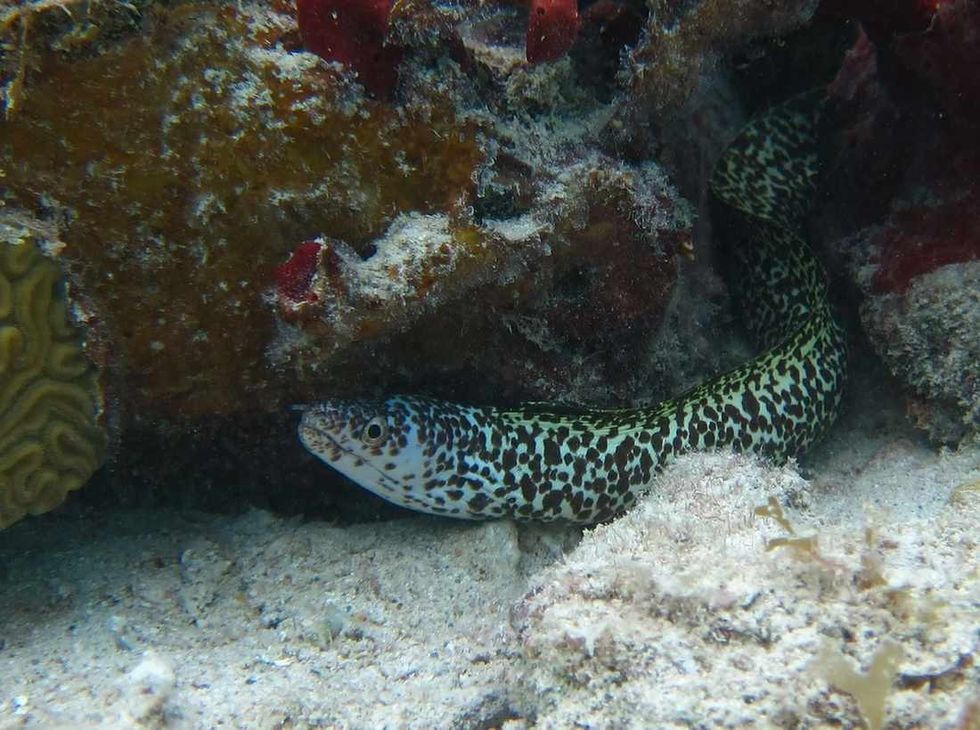Eels of this moray (Gymnothorax moringa) species are exceptionally amazing creatures of the world! These moray eels spend most of their time hidden in the sand, waiting for unsuspecting food to pass by, so they are a true ambush predator species.
To catch their meal, these moray eels extend their head and jaws out from underneath the sand and grab their prey with their strong teeth. These teeth can also be used as weapons during fights over food or territory.
They have very unique markings on them so you'll always know when one of these eels is around. Their patterns are really hard not to notice!
Brown spotted moray eel fish are known to be the most colorful eels thanks to their brown and orange spots, but they also have a dark side.
They spend a lot of time blending into coral reefs in order not to be detected by prey or predators alike.
In addition, their dorsal fin can vary between yellow, red, and green depending on how they feel at any given moment! They are able to change colors, allowing these fish to use lightening fast physical changes for camouflage instead of relying solely upon pigment cells as other animals do.
The spotted moray (Gymnothorax moringa) eel is typically found in waters that are deep, cold, and have strong currents. They usually prefer to live near rocky reefs, where they can hide from predators by curling up amongst rocks or partially swimming into them with their heads sticking out at an angle, ready for ambush mode.
The gold spotted moray eel will eat anything it catches, whether it is a crab, fish, or any other marine invertebrates. The spotted moray (Gymnothorax moringa) eel species has a long, slender body with a head and gills that are often hidden in an earthen burrow.
The mouth and throat are located at the front of its face and its teeth are on either side, allowing it to grab onto its prey and swallow it whole.
To find out more, read on. These black-spotted moray eel hunting facts will blow your mind!
For more relatable content, check out these ribbon eel facts and moray eel facts for kids.
Spotted Moray Eel Interesting Facts
What type of animal is a spotted moray eel?
Spotted morays (Gymnothorax moringa) are a type of eel. They are often found near a coral reef and they have a commendable sense of smell with a brilliant set of jaws!
What class of animal does a spotted moray eel belong to?
These spotted morays belong to the class Actinopterygii and they are mostly pale yellow in color.
How many spotted moray eels are there in the world?
Researchers estimate (not certain) that there could be between 500 million to 3 billion spotted morays in the world currently!
Where does a spotted moray eel live?
These eels of the family Muraenidae prefer to live in a coral reef in the ocean away from predators. They spend most of their time hidden under rocks and corals, where they can sneak up on unsuspecting prey with their brilliant sense of smell and catch them using their sharp jaws.
What is a spotted moray eel's habitat?
This moray is a North American and Pacific Ocean-based fish that thrives in the sea. It spends much of its time in shallow waters near a reef, where it looks for food such as crustaceans like crabs or smaller fish that swim by their hiding spot.
Who do spotted moray eels live with?
These morays live with dolphins, whales, and seals.
How long does a spotted moray eel live?
The average moray eel lives to be between 10-20 years old.
How do they reproduce?
These morays reproduce by laying eggs. A female will lay up to 10,000 eggs on the bottom of a reef in batches that are separated by coral or other objects. These separate batches aim to keep them from being eaten before they hatch into small baby eels.
What is their conservation status?
These morays have an IUCN conservation status of Least Concern.
Spotted Moray Eel Fun Facts
What do spotted moray eels look like?
This eel has a long, cylindrical body with six pairs of short fins. Its head is very large and bulbous in comparison to the rest of its body, which gives them their name 'moray', as they resemble an old-rowboat called a 'moraie'.
These eels possess strong jaws lined with teeth that are used for grabbing prey such as fish or crabs. Their colors vary slightly; some will be greenish-brown while others can range towards blue-green tones depending on the type.
How cute are they?
When you see these morays it's hard not to be in awe of their vibrant colors and unique features. This species is also able to change the color on its face depending on what mood they're feeling, which is so cool!
How do they communicate?
Moray eels have specialized jaws that allow them to generate intense pulses at frequencies matching those emitted by many types of prey. This sends vibrations through the ground-dwelling animal's sensitive organs. Morays can sense these tremors from several meters away!
How big is a spotted moray eel?
These morays are found along the coastlines of different regions and their average length is about 24 in (60 cm).
How fast can a spotted moray eel swim?
The average speed they go at is two body lengths per second, which means that in 10 seconds a single eel could cover 20 ft (6 m)!
How much does a spotted moray eel weigh?
Morays are not your typical marine fish, in fact, they can grow to weigh as much as 5.5 lb (2.5 kg).
What are their male and female names of the species?
Both males and females are popularly referred to as morays.
What would you call a baby spotted moray eel?
These cute little babies do not have any scientific names and are simply known as baby morays!
What do they eat?
These eels are voracious eaters and they will consume anything they can find including other fish, crabs, shrimps, or octopus if given the opportunity to do so.
Are they aggressive?
Yes, morays can be aggressive if provoked!
Would they make a good pet?
Morays are not a suitable species of animals to have as a pet. They are best left in wild marine zones with those strong jaws!
Did you know...
The cost of this beast varies greatly depending on where they live, but if none are found near your area, expect to spend about $5 per 1 in (2.5 cm).
Different types of spotted moray eel
The different types of spotted eel are Snyder’s moray, zebra moray, giant moray, slender giant moray, and snowflake moray.
Can moray eels kill humans?
No, it is not believed that they can! They may have strong and sharp teeth and jaws, but there haven't been any cases of this reported yet.
Here at Kidadl, we have carefully created lots of interesting family-friendly animal facts for everyone to discover! Learn more about some other fish from our hogfish facts and ladyfish facts pages.
You can even occupy yourself at home by coloring in one of our free printable moray eel coloring pages.









